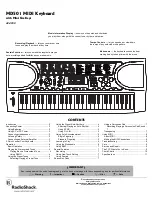
Program P7: EG 1-4 7–1: EG 1 (Filter)
199
Program P7: EG 1-4
There are four assignable EGs, in addition to the Amp
EG. Each of these can be used as an AMS modulation
source to control a wide variety of parameters.
There are also four parameters with dedicated EG
modulation inputs: Pitch for Oscillators 1 and 2, and
Frequency for Filters A and B. Any of the four EGs can
be used for these modulation routings.
In the midst of all this flexibility, we thought it would
also be good to provide a little structure. With this in
mind, EG 1 is named EG 1 (Filter) and EG 2 is labeled
EG 2 (Pitch).
Please take these names as suggestions, rather than
restrictions. If you like, you’re free to use these EGs to
control any EG or AMS destination, or to use other EGs
to control Filter Frequency and Pitch.
7–1: EG 1 (Filter)
The EGs, or Envelope Generators, let you create
complex, time-varying changes to AMS-modulatable
parameters. The controls on this page specify the shape
of the EG. Among other things, you can:
• Create the basic EG shape by setting the levels and
times of each segment.
• Control the curvature of each EG segment, for
subtle control over the sound of the EG.
• Set up complex modulation of EG levels and times.
• Set up an AMS source, such as an LFO, to restart
the EG.
One thing that you can’t do on this page is to control
how much effect the EG has on the parameters it
modulates. To do that. you’ll need to adjust the AMS
intensities on the pages for the individual parameters.
7–1a: EG Reset
AMS
[List of AMS Sources]
This selects an AMS source to reset the EG to the start
point. For instance, you can use a tempo-synced LFO
to trigger the EG in a repeating rhythm. This reset is in
addition to the initial note-on, which always causes the
EG to start.
For a list of AMS sources, see “AMS (Alternate
Modulation Source) List” on page 967.
Threshold
[–99…+99]
This sets the AMS level which will trigger the EG reset.
Among other things, you can use this to adjust the
exact point in an LFO’s phase at which the EG will be
reset, effectively controlling its “groove” against other
rhythmic effects.
When the threshold is
positive
, the EG triggers when
passing through the threshold moving upwards. When
the threshold is
negative
, the EG triggers when
passing through the threshold moving downwards.
Note
: with some LFO shapes, and with faster LFO
speeds, the LFO may not always reach the extreme
values of +99 or -99. In this case, setting the
Threshold
7–1PMC
7–1a
7–1b
7–1c
7–1d
Содержание Electronic Keyboard
Страница 1: ...Parameter Guide Parameter Guide ...
Страница 2: ......
Страница 180: ...Program mode EXi 170 ...
Страница 290: ...EXi STR 1 Plucked String 280 ...
Страница 572: ...Sequencer mode 562 ...
Страница 700: ...Global mode 690 ...
Страница 751: ...Insert Effects IFX1 IFX12 Routing 741 Fig 2 3a Fig 2 3b ...
Страница 902: ...Effect Guide 892 ...
















































